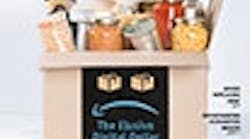Our cover story this month is about one of the most enigmatic issues the food and beverage industry must deal with: how to use the internet, and e-commerce in particular, to sell your products.
I’m using “sell” in the broadest of ways because, for probably 90 percent of the food and beverage industry, the selling of food in the traditional sense means having a grocer or other retailer sell it for you. The most you can do with consumers is to make them aware of your product, hopefully to have them look for it, maybe even request it from their grocer.
I realize food and beverage processors are busy, so we never get 100 percent participation when we put out a call for help in developing a story. But for this one the silence was deafening. Maybe the key question was too intimidating: “Tell us about some of your successes in e-commerce.” The second was just as daunting: “What efforts are you making to sell direct to consumers?”
Internet sales are booming in most other categories. The web has put most travel agents, booksellers and record stores out of business. More than a third of computer hardware is bought online, and many other categories are seeing similar penetration. So why not food? And why not from Nestle.com, not Amazon or Walmart.com?
The answers are reasonably obvious – just as obvious as the nonsense in making hamburgers out of vegetable protein ... or out of meat grown in a petri dish. Just as ridiculous as gluten-free food. And enhanced water. And premium-quality dog food.
Start with logistics. How do you get fresh food to consumers quickly and efficiently? How do you get refrigerated or frozen products there safely? How to ship heavy beverages in a cost-effective manner? Why would anyone pay $5 shipping for a $4 item?
Then there are the traditional shopping habits (and for these insights I thank IRI). Particularly for perishables, consumers want to touch, feel and see. For many other categories, it’s a need-it/want-it-now situation.
Download your own copy of the October 2018 issue of Food Processing. Register to download
Then there are the food and beverage companies themselves. For the established ones, their strong suits are product development and manufacturing. And marketing. And lately, mergers and acquisitions. Not small-order fulfillment.
I attend the Consumer Analyst Group of New York meetings every February, where the CEOs and CFOs of public food and beverage companies “sell” their companies’ projected performance for the new year to the financial community. Vague discussion of e-commerce is rampant there. Most of the food executives talk in the most general terms of their e-commerce efforts; and if not, they’re asked about it in the Q&A. Their answers are general and vague.
For this cover story I read many market research reports, many of them promising you can “learn from the leaders” or trailblazers. But the only “trailblazers” mentioned were Amazon and Walmart.com. It’s apparent no food company has it figured out.
Click and collect undoubtedly is catching on and solves most of the logistics problems. It requires some labor-shuffling at the grocery store, but it’s a relatively small price to pay for Kroger and others to stay in business.
Amazon Prime counters most of the logistical problems, too. For $79 a year you get free two-day shipping – surely you can wait that long for your Cheerios. Oops, that was the introductory price, now Prime is $99 a year. I mean, $12.99 a month or $119 for the full year. At least that was the price when I wrote this; it may have gone up again.
What’s that leave? Niches and superpremium. The former is the bane of most big food companies, the latter is a holy grail. One case history I found interesting was from Kellogg’s granola brand Bear Naked. On its website, I could create my own granola “with over 50 chef-inspired ingredients.” If my concoction got a little too crazy, IBM Chef Watson would step in and question my sanity. In the end, I got to name it and to choose one of five bears to be pictured on my canister. My 11-oz. creation cost $9.99, including postage.
I’m not going to pay $10 for granola. But I don’t buy cage-free eggs, either, nor organic milk. But I know some people who do.
This whole e-commerce thing sounds like a lot of effort and expense just to chase a few dollars. But is it any crazier than spending $8 billion on a niche dog food company? Or half a billion on a bottled water company? Time will tell.

